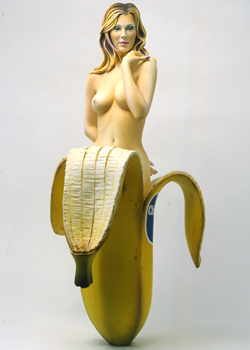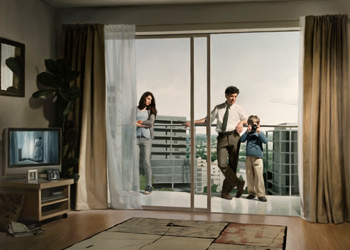Uncategorised
But It’s Art, Darling

A giant bronze gorilla. Tables groaning under the weight of (what looks like) piles of horse manure. A towering blonde nude, morphing into a banana. A live hermit crab. An eight-foot model of Mickey Mouse, with its innards exposed.

Mel Ramos, Chiquita Banana, at PAD
These were just some of the incredible sights your glamorous correspondent, Juno Moneta, saw last week during London's annual art fairs.
Considered by many as the social highlight of the year, the capital's week-long smorgasbord of art provides a telling bellwether for the confidence levels of the super-rich. Most of the art on display is contemporary, be it at Frieze Art Fair in Regent’s Park or The Pavilion of Art and Design in Berkeley Square, All Visual Arts, The Museum Of Everything, The Lisson Gallery or The Haunch of Venison.
Unlike a rare Picasso or Giacometti, contemporary art has not stood the test of time as an entity with investment vehicle potential. It is unlimited, and its producer could go on to make many more in their lifetime. While a classical artist like Monet has at least has tripled in value over the last twenty years, a hermit crab housed in a replica mask is unlikely to offer such great long-term value. This type of art is often seen as synonymous with the boom years of 2006 and 2007, when a wealthy individual would barely bat an eyelid at spending ÂŁ50 million (over $75 million) on a diamond-encrusted skull.
As Ms Moneta fantasised about what art she would buy with a spare ÂŁ50 million, she considered taking home one of the more 'challenging' pieces. But in practical terms, what would she do with it?
Although it was cute, the novelty of owning a hermit crab living in a bronze mask (Recollection, by French artist Pierre Huyghe at Frieze) would soon wear off. What do hermit crabs eat, for a start? How do you clean them?
And even her most cultured friends would probably raise an eyebrow, upon entering the kitchen to find, nestled up to the Aga, a table covered in what looks like animal dung (Dirt Piles, Patrick Jackson, the Ghebaly gallery at Frieze). This sort of art is clearly reserved for people so rich, their houses resemble sprawling, minimalist art galleries.
And yet, and yet. Defying the volatility rocking the global markets and the morbid eurozone debt crisis, the rich were out in force. And they were spending. The likes of supermodel Elle Macpherson and Russian entrepreneur Evgeny Lebedev graced the red-carpeted marquee of Frieze. The manure-covered tables were reportedly snapped up for $9,000 within two hours of opening, while oil painting the Haus des Lehrers by Neo Rauch at the David Zwirner gallery reportedly fetched $1.35 million on the VIP preview day.
Meanwhile French billionaire and owner of auction house Christie's, Francois Pinault, reportedly splashed out on two of Jonathan Wateridge's vast 3 metre by 4 metre oil paintings, which currently retail at up to ÂŁ250,000. Wealthy German art collector Thomas Olbricht has also bought Wateridge's work, which is currently exhibiting at the All Visual Arts gallery in King's Cross.

Jonathan Wateridge, Matinee, at AVA
Founder of AVA, Joe La Placa, told Ms Moneta that Eurozone fears are driving the wealthy to spend more than usual on art - but only on the good stuff.
With the 'fear index' for the survival of the Euro on def com four, many investors are fleeing financial products and putting their cash in blue chip, asset quality art, mainly at the high end. The lower, more risky end of market for 'unknown' artists however has seen a noticeable downturn," he said.
Although Frieze would not immediately confirm how much art had sold so far, around $350 million was on sale last week, according to estimates by insurer Hiscox. A record number of galleries were present, with 173 galleries representing 33 different nationalities. Given that it can cost as much as $50,000 to put on a show overseas, according to one gallery owner, these galleries must firmly believe in the power of the wealthy wallet.
Ursula Krinzinger, an Austrian art dealer and owner of the Galerie Krinzinger, and a lobbyist for contemporary art, was upbeat about the demand for Gavin Turk prints over the first two days.
“We were pleasantly surprised with the interest on the first day. No doubt the last two years have been difficult, people have been uncertain because of the recession. There is still much uncertainty, but the best, more established artists are still selling well,” she told Ms Moneta at the Frieze fair, sponsored by Deutsche Bank.
And as inflation and rock-bottom interest rates result in a negative yield on cash, bonds and equities are being trashed everywhere, property prices have slumped and even gold is yo-yoing as a result of the global volatility, Ms Moneta reflects that a table of dirt is not such a bad alternative to the financial markets, after all.
And La Placa believes there is a reason why the art this year had a frivolous tone to it - or at least, more so than usual. "During the depression, escapist films (the lavish musical productions) served as a palative for the economic woes society was enduring. In the latest Frieze Fair, this year overshadowed by Europe's economic downturn, there was a similar trend towards the decorative at many stands. One noticed a preponderance of unchallenging, brightly coloured sculptures of lurid flowers at a good number of the booths that would normally dole out a more gritty, tougher kind of work.
Well if it makes you happy, it can't be that bad.